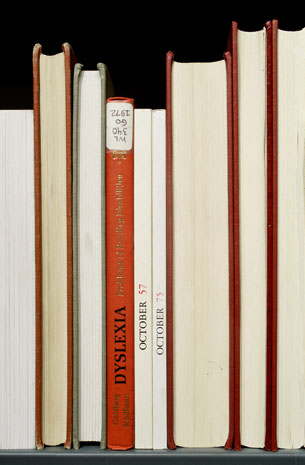Curatorial Statement
Here Lies the Sprawling Curatorial Statement
Let’s get to books, the matter at hand. The well-read artist is no rarity; collaboration or correspondence between artists and authors has never been limited. Often a book accompanied the sitter of a portrait, identified a Gospel author, or ornamented an Ancient philosopher. The book is a common complement in the portrait: Magni’s Reading Girl at the NGA. Manet’s portrait of Zola. R.B. Kitaj set a precedent with his portfolio of 50 screenprints, In Our Time: Covers for a Small Library…, printed in 1969. Illuminated manuscripts reflected on the book form itself, but not until the middle of the 20th century, amid hand-painted Pop and vernacular photography, were books given their own space in painting, photography and sculpture.
Books are rife with signifying potential. The unopened work on the bookshelf embodies the Canon and a purely potential experience for the mind. The book not-yet-read can cause stress; the unappealing cover could send a book to the remainder bin. The imposing stack of books conveys a scatter-plot biography of the owner. Or sprawling shelves emblematize power structures in museum and library bureaucracy.
The three artists featured in this web exhibition portray the book as a self-standing object. The depiction of books–two-dimensional platforms inundated with text–tends to either focus on the graphic design of the cover or the archetype of the book shape.
The works herein come from the photographs of Nina Katchadourian, the sculpture of Rachel Whiteread, and the painting of Steve Wolfe. These artists depict books, but not illuminated manuscripts. Wolfe translates the covers of trade paperbacks into oil and prints on paper or wood. Katchadourian scours libraries to compose snippets of poetry or narrative from book spines. Whiteread casts the shelves of libraries and presents the negative space as sculpture.
Praising the Kindle e-reader in March 7th 2010’s New York Times Magazine, Virginia Heffernan writes, “The device…leaves nothing to the experience of books but reading. This strikes me as honest, even revolutionary.” It is a misguided Modernist sentiment Heffernan rephrases, that stripping an object of artifice brings us closer to truth. A text intends itself only as text, but illuminated manuscripts and $30 hardcovers show that we cherish more than the words on a page. Caldecott medal winners continue to please the imagination of children while marketing wizards can turn an unknown text into a bookshelf staple (v. the NY Review of Books series, which pairs prestige and graphic design to sell forgotten classics). Most of the artists cited here focus on the book covers—in imitation of graphic design–and not the body text at all. One can refer to Andy Warhol’s translating his graphic design background into a fine arts method. Warhol’s screenprints mirror the reproducible, the cheap, the mass-market quality of the paperback cover.
Only Whiteread relies on the ambiguous quality of unnamed books, as her casts often present the pressed pages instead of the book spine. Katchadourian’s photographs come forth with more humor than sobriety, like a found text of one-liners or miniature fables. Wolfe recreates the books entirely, either as wood panels or flat covers.
Victoria Reichelt says, quoted in Peter Terzian’s article “The Painted Book,” “In a painting, books serve a very different purpose from their intended function. They are purely objects like any others, with histories and narratives of their own, quite separate from the text inside them.” Simon Morley, in the same Print article, echoes, “By painting a book cover, you could evoke the feeling of something that’s present, in front of you, that evokes something that’s absent, the content inside.” The content of a book cannot accompany these visions of its exterior. Instead, we witness the book as idea, the book as hackneyed, storied, specific object, the book as item of culture, the book as ideology, the book as personal anecdote.
In a digital age, age of the Kindle and the internet phone, the necessity of paper slips from our lives. These artists portray an out-moded commodity—the tangible book—in aging forms, when illustration is being converted to a digital effect, photography is losing film. Welcome to the WordPress blog, where newspaper’s journalism and the pocket-sized journal become html files. The movable type of Gutenberg is outpaced herein, but the artists included here translate the book back into handcraft.


